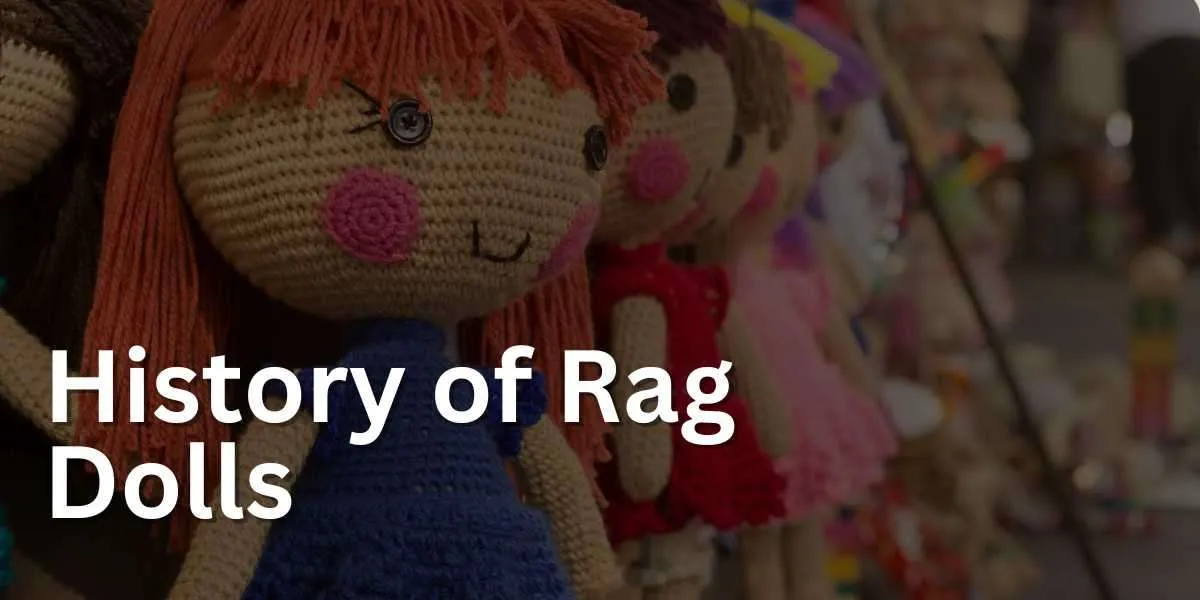Venturing into the rich history of toys and curious about the origins and evolution of rag dolls? You’re tapping into a narrative that spans centuries and cultures. Rag dolls, with their humble materials and heartfelt craftsmanship, have been cherished playthings and artifacts of cultural significance for ages.
Rag dolls hold a special place in the hearts of many, not just as toys, but also as historical records that offer insights into the societies that produced them.
Drawing from my expertise in cultural history and toy evolution, I’ve stitched together a comprehensive guide that traces the journey of rag dolls through time. This exploration will take us from ancient civilizations to modern-day interpretations, highlighting the importance, craftsmanship, and cultural nuances associated with these fabric figures.
Let’s weave through history together, discovering the rich tapestry that tells the enduring story of rag dolls and their place in the world.
Key Takeaways on History of Rag Dolls
| Time Period | Description |
|---|---|
| Ancient Civilizations | Rag dolls have been discovered in archaeological digs from ancient Roman, Egyptian, and Greek civilizations. These early dolls were likely used both as playthings for children and as religious symbols or offerings. |
| Medieval Period (500 AD – 1500 AD) | Cloth and rag dolls continued to be popular during the Middle Ages. They were often homemade, crafted by mothers for their children using scraps of worn clothing or other materials. |
| Renaissance (14th – 17th century) | As trade and commerce expanded, dolls made from finer materials began to emerge. However, rag dolls remained a staple, especially among the lower classes. |
| 18th & 19th Century | The Industrial Revolution brought about mass production, and while porcelain and bisque dolls became fashionable, rag dolls were still beloved for their softness and durability. During this period, “black rag dolls” made by and for African American children became significant in the U.S., often crafted with African features and reflecting cultural heritage. |
| 20th Century | Commercially produced rag dolls became widely available. Iconic rag dolls, such as Raggedy Ann and Andy, introduced in the 1910s, became cultural mainstays in the U.S. Rag dolls were also used as comfort items during wartime, being lightweight and easy to transport. |
| 21st Century | The modern era has seen a resurgence of interest in traditional and handmade toys. Rag dolls are cherished for their nostalgia, simplicity, and the ability to be customized. They’re also seen as sustainable alternatives to plastic dolls. |
When Was the Rag Doll Invented
As rag dolls are traditionally made of scraps of materials it’s very hard to determine when or where they were “invented”.
Handmade and often given as a first toy not many examples of early rag dolls have survived. Their very nature means they would disintegrate over time. But this is also part of their appeal. The fact that they can be carried around loved and patched up when they get tatty makes them perfect toys for little ones.
Despite not many examples surviving there are examples of early rag dolls including an American rag doll named Bangwell Putt thought to date back to around the 1770s. As well as a Roman rag doll housed in the British Museum that was found in a child’s grave and believed to date somewhere between the 1st and 5th century AD.
The earliest known rag doll was discovered in Egypt and dates back to the 1st century AD made from scraps of rags and papyrus. Corn husks were also a popular material for doll making in other parts of the world.
It is generally thought that rag dolls would have been given to children to act as comforters as well as toys. And that they would also have been used as educational toys to teach children about nurturing and also to teach sewing skills as a young girl would be able to make new clothes for their dolls with small scraps of material and stuffed cloth body.
Rag dolls also have a long history in Mexico and have been revived as part of the tourist industry in the 1970s as part of a program to support the local economy.
Commercially produced Rag Dolls
Rag dolls began to be mass produced around 1830, roughly the same time that fabric color printing began. Yet despite being mass-produced, the dolls retained their simple features, soft bodies and often even the patchwork clothing.
Now there are many companies making soft dolls. Some are designed to look like more traditional rag dolls with hair made of yarn and colourful patchwork clothing. Others are still hand made even if this is on a commercial basis.
Rag dolls in popular culture
The rag dolls or cloth dolls universal appeal to young children as children’s toys has led them to be featured in a number of children’s books and TV series.
Golliwog was a 19th-century rag doll character as was Raggedy Anne, a rag doll with red yarn hair and a triangle nose, who may have been the inspiration for the TV show Rag Doll Anna in the 1980s.
The Raggy dolls was a popular TV series in the 1980s and Rosie and Jim another child’s TV show in the 1990s. And of course, there’s the slightly spooky-looking Sally from the nightmare before Christmas.





